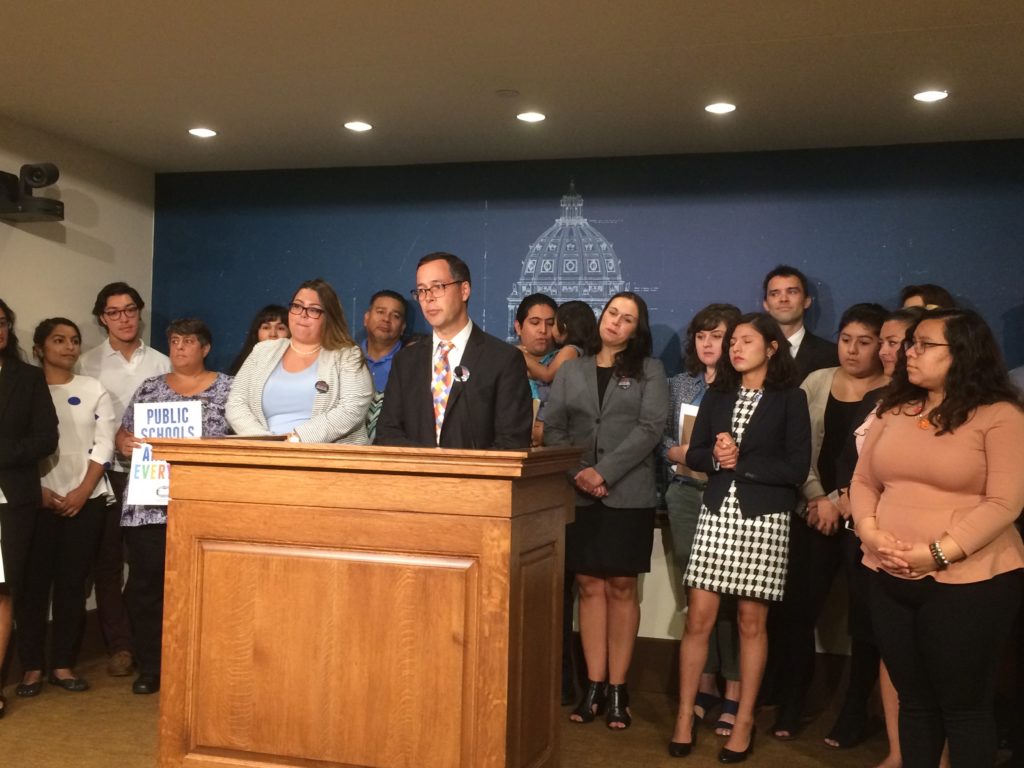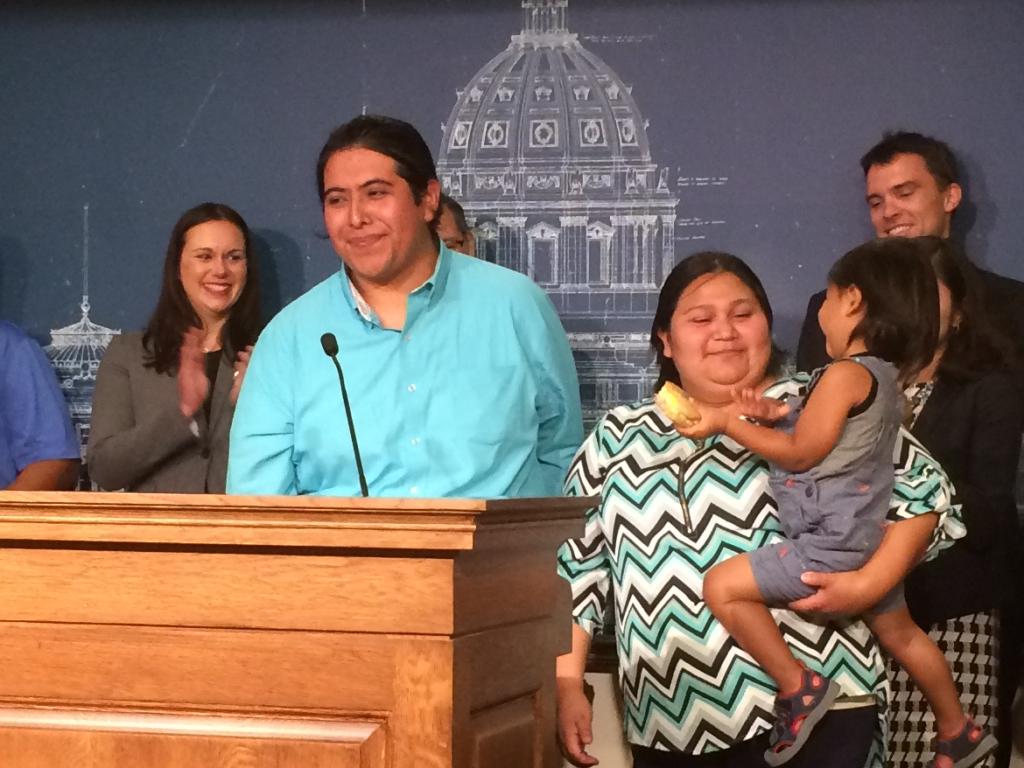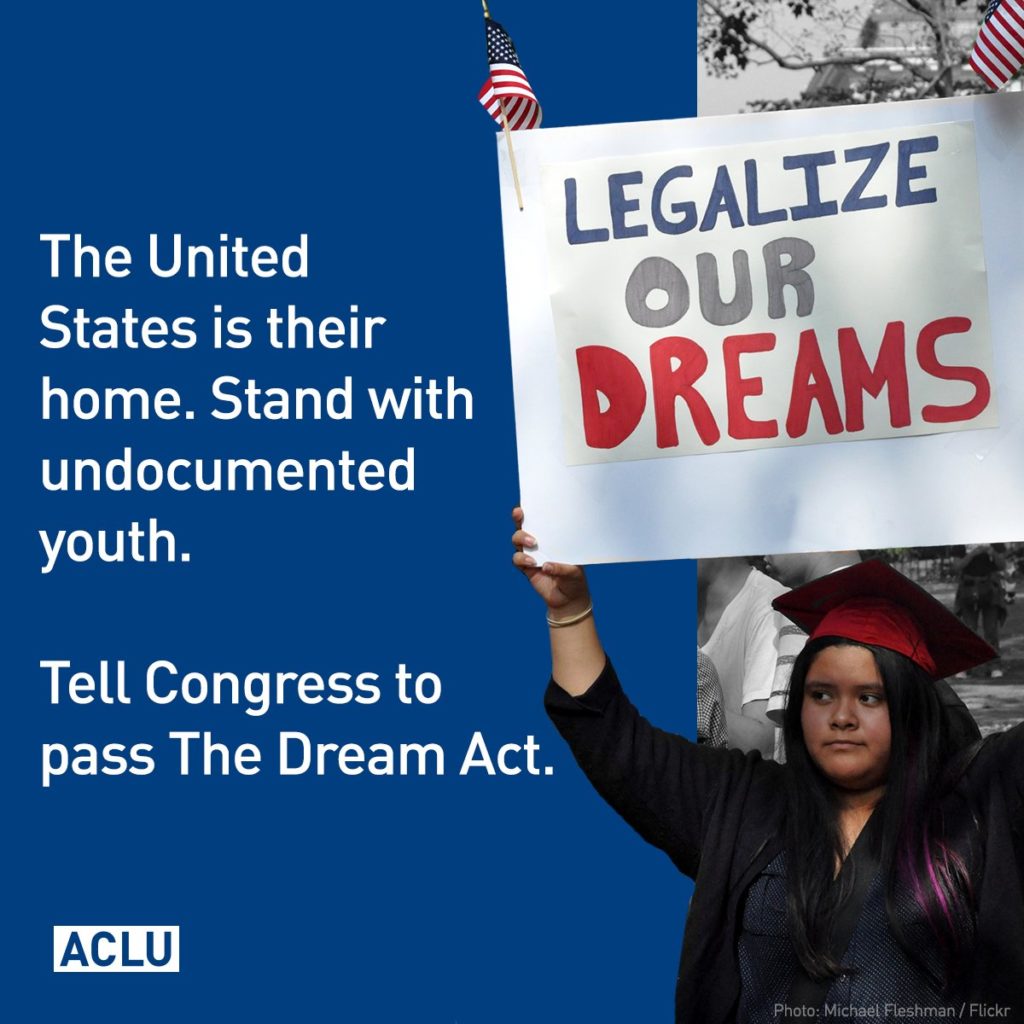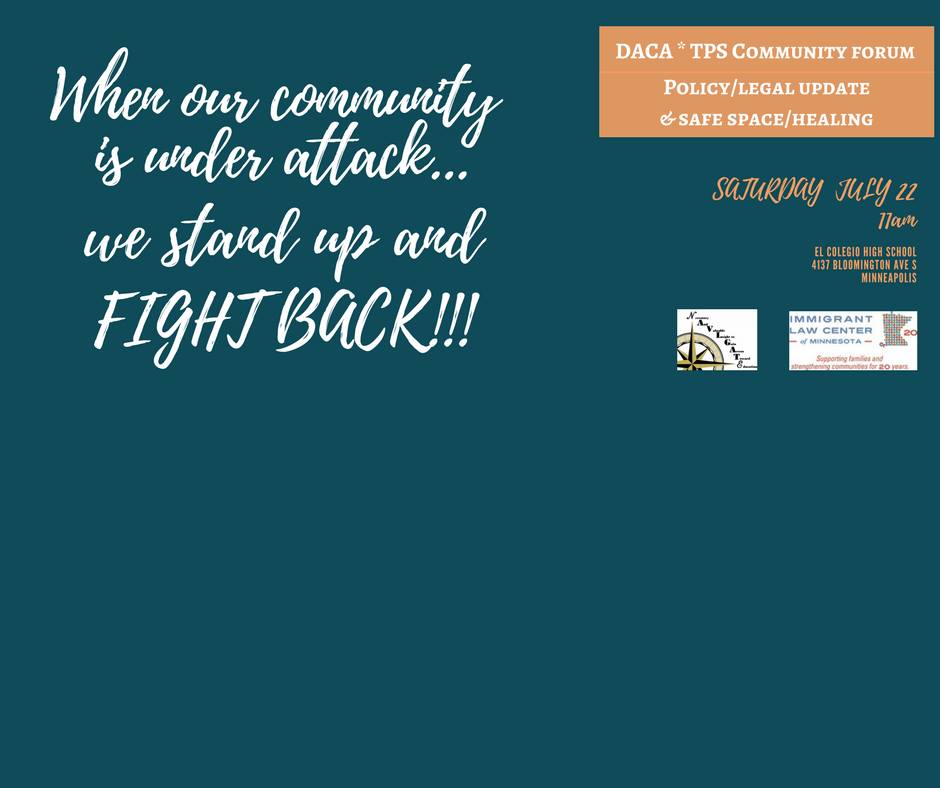Archives
Defending the Dreamers: Looking to DACA and the future

Five years ago, John Keller recalled, people started lining up at Green High School in Minneapolis at 10 p.m. on the night before the first DACA information meeting. Some 700 people packed the meeting the next day, as the Immigrant Law Center of Minnesota (ILCM) and Navigate-MN helped them begin the process of applying for DACA – Deferred Action for Childhood Arrivals. Then and now, DACA changes lives, protecting young immigrants from deportation for two years, and giving them work authorization and social security numbers.
ILCM Executive Director John Keller, Navigate-MN Executive Director Emilia Gonzalez Avalos, and Mirella Ceja-Orozco of the American Immigration Lawyers Association Minnesota chapter spoke at a press conference at the Minnesota State Capitol on August 15 to mark the fifth anniversary of DACA, along with DACA supporters and advocates and recipients.
Uriel Rosales-Tlatenchi is one face of DACA. He crossed the border with his parents 18 years ago, when he was only 9 years old. Uriel grew up in Minneapolis, graduated from the University of Minnesota-Twin Cities, and was one of the first DACA applicants in Minnesota. He vividly recalls his continuing fear of deportation.
He became an activist, working as the first executive director of Navigate-MN to advocate for legal status for Dreamers – the young people who grew up in the United States without legal status. In 2012, President Obama instituted DACA, which provides a limited, temporary status with no path to legal permanent residence or citizenship. Only Congress can provide that path.

When Uriel got DACA status, he says, “I was no longer afraid.” He could get a driver’s license, and could work in whatever field he chose. Since then, he has married and has a two-and-a-half year old son. He works, pays taxes, and contributes to the state with his civic involvement.
Across the country, nearly 800,000 young people have gained DACA protection during the past five years. In Minnesota, ILCM has helped more than 3,000 young people through the DACA application process. By the end of March 2017, some 6,255 Minnesotans had gained DACA protection, coming from every congressional district in the state.
Young immigrants, who were brought here by their parents before they turned 16 and were younger than 31 on June 15, 2012, may be eligible for DACA. They also need to meet other qualifications, apply, pay fees, and pass a background check.
Like Uriel, 92 percent of DACA recipients are either employed or enrolled in school and 90 percent have either a drivers license or state ID. Some 54 percent have purchased their first car and 12 percent are first-time home buyers. Six percent have started their own businesses, a rate of entrepreneurship nearly double that of native-born citizens.
DACA authorization is good for two years – then it must be renewed. The program itself also has to be renewed every two years. The next time it’s up for renewal is 2018, and nobody knows what Trump will do. He has threatened to end DACA, promised to protect the young people with DACA status, and generally left everyone uncertain of what to expect. DACA currently faces a legal challenge from Texas and nine other states. Will the Department of Justice defend DACA in court? Again – no one knows what to expect from this administration.
If the president decides to end DACA or if the Texas-led state attack succeeds, almost 800,000 young people will be suddenly deportable. The impact on the national economy would be huge. According to the Cato Institute’s estimate:
“[A] repeal or roll-back of DACA would harm the economy and cost the U.S. government a significant amount of lost tax revenue. We estimate that the fiscal cost of immediately deporting the approximately 750,000 people currently in the DACA program would be over $60 billion to the federal government along with a $280 billion reduction in economic growth over the next decade.”
“The State of Minnesota needs every last immigrant and every last DACA recipient,” said John Keller. He cited studies showing that Minnesota, DACA recipients pay an estimated $15 million in taxes every year, and that ending DACA would reduce Minnesota’s Gross Domestic Product by $367 million per year.
Most Americans support Dreamers. A Morning Consult/Politico poll showed strong support for Dreamers, all along the political spectrum:
“In a Morning Consult survey from late April, almost 4 in 5 (78 percent) registered voters said the Dreamers should be allowed to stay in the country, with more than half (56 percent) expressing support for eventual citizenship….
“There was also broad support in favor of the Dreamers among the voters who helped elect Trump in November: 73 percent of those voters said the Dreamers should be allowed to stay in the country, with almost half (48 percent) of those voters also saying they should have a path to becoming U.S. citizens.”
Protecting DACA is a first step, but Dreamers need permanent status that can come only with passage of the DREAM Act by Congress, establishing a path to permanent legal residence and citizenship.
x x x x
Trepidation in the Heartland
Farmers and food processors worry anti-immigration policies will harm their businesses—and Minnesota.
What’s in the latest Republican anti-immigration legislation?

Though it has little chance of passing, the Raise Act sponsored by two Republican senators and endorsed by the president has already raised the level of fear and confusion over immigration in the United States. Its provisions privilege English-speaking immigrants at the expense of family reunion visas and refugees. Overall, legal immigration would be cut in half. Refugee admissions would be permanently reduced to 50,000 per year. Except for spouses and minor children, family-related visas would be abolished. The diversity visa program would be abolished.
Touted as “merit-based,” the Raise Act defines merit based on a point system. Prospective immigrants would get points for:
- Age – best age? Prospective immigrants get 10 points for being 26-31 years old. Worst age? Immigrants over 51 get zero points for age.
- Education – generally, more education gets you more points. A U.S. bachelor’s degree counts for more than a foreign bachelor’s degree, and advanced STEM degrees pile on even more points. Advanced degrees in the humanities or in social sciences or law: zero points.
- Speaking English – higher proficiency scores mean more points.
- Extraordinary achievement – science awards count for more than Olympic medals, but both count for a lot. Nobel Peace Prize? Nobel Prize for literature? Sorry – no points for those.
- Job offering – in general, higher salaries mean more points, but you don’t get any points unless you have a college degree.
- Investment in a new commercial enterprise – Got millions? You get six points for agreeing to invest $1.35 million and twelve points for $1.8 million.
The title of the legislation, “Reforming American Immigration for a Strong Economy Act,” signals its exclusive focus on money as the measure of everything. One of the final sections of the proposed legislation calls for a report in four years to recommend revisions for the purposes of
“(A) increasing per capita growth in the gross domestic product of the United States;
“(B) enhancing prospects for the economic success of immigrants issued points-based immigrant visas;
“(C) improving the fiscal health of the United States; and
“(D) protecting or increasing the wages of working Americans.”
As the Los Angeles Times points out, this is a stark contrast to the current system, which “favors uniting family members with relatives already in the country and was built on the premise that any person, regardless of what language they speak, how much education or money they have, can seek to come to the United States.”
Businesses and farms that rely on immigrant workers are speaking out against this legislation. The Raise Act seems unlikely to pass, since many Republicans in Congress, as well as Democrats, already oppose it.
For more information:
- The official text of the Raise Act, as introduced in February can be found here: https://www.congress.gov/bill/115th-congress/senate-bill/354/text
- The expanded text of the Raise Act, as announced on August 2 by Senators Cotton and Perdue and President Trump, can be found here: https://www.cotton.senate.gov/files/documents/170802_New_RAISE_Act_Bill_Text.pdf
- Trump is pushing for a ‘merit-based’ immigration system that slashes the number of legal immigrants (Los Angeles Times, 8/2/17)
- FACT CHECK: Trump immigration pitch on shaky ground (AP via Star Tribune, 8/3/17)
- http://www.latimes.com/politics/la-na-trump-immigration-20170802-story.html
- Donald Trump announces new immigration policy favoring financially stable English speakers (Independent, 8/2/17)
- Trump endorses bill to cut legal immigration, award visas based on merit (Bloomberg, 8/2/17)
- https://www.bloomberg.com/news/articles/2017-08-02/trump-endorses-bill-to-award-immigrant-visas-based-on-merit?cmpid=BBD080217_BIZ
- Opinion: Trump says the proposed immigration bill will raise wages for Americans. It won’t. (Washington Post, 8/2/17)
- Trump, GOP senators introduce bill to slash legal immigration levels (Washington Post, 8/2/17)
- https://www.washingtonpost.com/news/post-politics/wp/2017/08/02/trump-gop-senators-to-introduce-bill-to-slash-legal-immigration-levels/
- It’s a ‘grave mistake’ to cut legal immigration in half (Washington Post, 8/2/17)
- Trump Unveils Legislation Limiting Legal Immigration (NPR, 8/2/17)
- Trump supports plan to cut legal immigration by half (New York Times, 8/2/17)
- CNN’s Acosta, White House aide clash over immigration at briefing (CNN, 8/2/17)
- Stephen Miller couldn’t defend new immigration bill without demeaning the press (Vox, 8/2/17)
The Real Immigration Crisis in Minnesota
The danger to Minnesota’s economy isn’t a flood of immigrants—it’s when they stop arriving.
Sorting out the Dream Acts
 The Dreamers – young people who grew up here after being brought to the United States as children — are under attack again. After Congress tried and failed to pass the Development, Relief, and Education for Alien Minors (DREAM) Act over and over again, President Barack Obama acted to protect these young people. In 2012, he established the Deferred Action for Childhood Arrivals (DACA) program. Young people who qualified for DACA received temporary protection from deportation and permission to work, renewable under new presidential orders every two years.
The Dreamers – young people who grew up here after being brought to the United States as children — are under attack again. After Congress tried and failed to pass the Development, Relief, and Education for Alien Minors (DREAM) Act over and over again, President Barack Obama acted to protect these young people. In 2012, he established the Deferred Action for Childhood Arrivals (DACA) program. Young people who qualified for DACA received temporary protection from deportation and permission to work, renewable under new presidential orders every two years.
That was then. Trump is now. As a candidate, he said he would end DACA. As president, he has waffled back and forth. Now Texas and nine other states, in a letter to the president from the states’ attorneys general, have threatened to sue if the administration doesn’t start phasing out the program by September 5. On the other side, 20 state attorneys general have written to the president asking him to protect DACA, as have 42 U.S. Senators.
While he was Secretary of Homeland Security, John Kelly said that, even though he personally supported DACA, there might be no legal grounds to support it in court. Now Kelly, a strong anti-immigrant voice within the administration, has moved up to a position as White House Chief of Staff.
Meanwhile, the Dream Act is alive again in Congress. On July 20, 2017, Senators Lindsey Graham (R-SC) and Dick Durbin (D-IL) introduced the Dream Act of 2017. A week later, two bills were introduced in the House of Representatives that would protect also Dreamers – the bipartisan Dream Act of 2017, introduced by Ileana Ros-Lehtinen (R-FL) and Lucille Roybal-Allard (D-CA), and the American Hope Act, introduced by Nancy Pelosi (D-CA), Congressman Luis Gutierrez (D-IL) and the Congressional Hispanic Caucus.
The National Immigration Law Center (NILC) published a side-by-side comparison of the 2010 and 2017 Dream Acts and DACA, which generally shows the 2017 Dream Act as more inclusive than DACA or the 2010 legislation. I haven’t seen a comparison of the 2017 Dream Act and the American Hope Act. Any Dream Act version, however, would provide legal protection for Dreamers and current DACA recipients, rather than leaving them subject to the whim of the president.
Most Americans support Dreamers. A Morning Consult/Politico poll showed strong support for Dreamers, all along the political spectrum:
“In a Morning Consult survey from late April, almost 4 in 5 (78 percent) registered voters said the Dreamers should be allowed to stay in the country, with more than half (56 percent) expressing support for eventual citizenship….
“There was also broad support in favor of the Dreamers among the voters who helped elect Trump in November: 73 percent of those voters said the Dreamers should be allowed to stay in the country, with almost half (48 percent) of those voters also saying they should have a path to becoming U.S. citizens.”
Would any Dream Act have a chance of passage in this Congress? And if a Dream Act passed, would the president sign it? In today’s chaotic national political scene, that’s impossible to say.
Immigrant nation: Contributing to the community
From Chinese immigrants raising money for Shoreview’s library to a new Eritrean refugee quickly finding work: Part 2 in 3-part series
Ellison questions Stanek policies on immigrants

Minnesota Congressional Representative Keith Ellison is challenging Hennepin County Sheriff Rich Stanek over jail policies that help Immigration and Customs Enforcement (ICE).
Stanek’s jail policies help locate and deport immigrants, whether they are documented or undocumented. Whenever a foreign-born inmate is booked into Hennepin County Jail, the jail alerts ICE, according to a July 26 report in the Star Tribune:
“When deputies book inmates, they ask for their city of birth and citizenship. Stanek says inquiring about birthplaces is required by Minnesota statutes and allows his office to notify consulates. With foreign-born inmates, deputies call ICE and sometimes put that inmate on the phone with an ICE agent.
“The jail also provides ICE agents space to meet with inmates and notifies the agency when an inmate with an ICE detainer is about to be released.”
Sheriff Stanek does not hold inmates past their scheduled release date on ICE warrants, which have been held unconstitutional by a number of courts. Instead, his practice seems to go one step beyond the warrant procedure in helping ICE locate and deport people.
Now Minnesota Congressional Representative Keith Ellison is asking for answers from Stanek about exactly what is asked and whether prisoners are advised of their right not to talk to ICE or given access to an attorney before being questioned by ICE agents. Specifically, Ellison wants answers by close of business on Friday, July 28 for the following questions:
- What access to Hennepin County sheriff’s Office (HCSO) inmate databases and other booking information does ICE receive? How regularly is this information provided, and on what grounds?
- Please list the questions that all detainees booked at Hennepin County jails and detention facilities are asked as part of standard intake procedures, as well as the point in the process when ICE is notified, how they are notified, and how communication with ICE is tracked.
- It was reported on July 7, 2017 that when HCSO deputies book inmates, they inmates for their country of birth and citizenship information. On what legal basis are your deputies soliciting this information from people booked at your facilities? What notification, if any is given to inmates about whether they are required to submit the information?
- The same report stated that with foreign-born inmates, HCSO deputies call ICE and sometimes put the inmate on the phone with an ICE agent or bring ICE to question them in person. What notification, if any, are detainees given that they are not required to speak with ICE either over the phone or in person?
- What percentage of detainees who are interviewed by ICE at your office receive legal representation during or prior to these interrogations?
- How and when does transfer of detainees to ICE custody happen? Please describe the chain of actions that HCSO takes to facilitate transfer of HCSO detainees to ICE custody.
- In 2016, how many total estimated hours did HCSO staff spend assisting ICE, or other federal immigration enforcement agencies?
- Hennepin County is estimated to have spent nearly $1.5 million on detaining undocumented immigrants in 2015 alone, according to the National Institute of Corrections and the Department of Justice.
What is the estimated overall cost of HCSO staff time spent assisting ICE and other federal agencies with federal immigration enforcement for the current fiscal year?
Immigration advocates, public defenders, and a host of other critics want a change in the jail’s policies. That seems unlikely to happen. According to the Star Tribune article, even the County Board can’t tell Sheriff Stanek what to do:
Over the past year, [Public Defender] Moriarty and advocates such as John Keller at the Immigrant Law Center have asked Stanek to stop sharing information with ICE. Commissioner Greene’s office explored ways of preventing sheriff’s employees from doing so, but the County Board has no authority over Sheriff’s Office policy.
Some immigrants face Catch-22 as ICE takes a harder line on detention
In Minnesota, more immigrants facing criminal charges are held with high or no bond, making it hard to fight their cases.
What happens to DACA on September 5? ILCM and Navigate answer.
 What’s going to happen on September 5? That question was on many minds on the sunny Saturday morning in El Colegio’s cafeteria, one of many questions at the Navigate/Immigrant Law Center of Minnesota policy/legal update. September 5 is the deadline set by the Texas attorney general’s letter to President Trump. The letter, signed by ten state attorneys general, threatens legal action to overturn DACA unless the president agrees to phase out the program.
What’s going to happen on September 5? That question was on many minds on the sunny Saturday morning in El Colegio’s cafeteria, one of many questions at the Navigate/Immigrant Law Center of Minnesota policy/legal update. September 5 is the deadline set by the Texas attorney general’s letter to President Trump. The letter, signed by ten state attorneys general, threatens legal action to overturn DACA unless the president agrees to phase out the program.
The September 5 date is a threat, not a legal deadline, ILCM director John Keller said on July 22. This is a political moment. No one knows exactly what will happen.
On July 21, 20 state attorneys general, including Minnesota Attorney General Lori Swanson, responded to the threat. They wrote to Trump to defend DACA. That’s twice as many state attorneys general defending DACA as those who signed on to the Texas attorney general’s letter attacking DACA.
There could be several scenarios ahead for DACA, Keller explained. Despite the Texas threat to file suit on September 5 to end DACA, the possibilities remain the same as those talked about since the election:
- The president could defend and protect DACA and it could continue as it has – he could order the U.S. Attorney General to defend DACA against lawsuits or he could pressure the 10 Republican state attorneys general to stop their lawsuit.
- The president could modify DACA and say that only those who have applied prior to a certain date could receive DACA and continue to renew work permits, but that no new applications would be granted.
- The president could say that no new applications would be accepted, and that people who have DACA can use their work permits only until they expire and not renew them.
- The president could shut down on DACA on a specific date and cancel work permits as of that date.
In the worst case scenario, asked one person, what should a person with DACA do?
“If you have not had a comprehensive consultation with an immigration attorney in the past year, do that,” Keller said. “Consult an immigration attorney to see if there is any additional protection that might be available to you. Do that even if you have worked with an attorney on your DACA. It’s still worth a legal update or a legal check-up to see if there is any new scenario that would be helpful.”
Keller began the July 22 policy/legal update with thanks for the work that Navigate-MN does in the community. While ILCM represents immigrants in courts and immigration proceedings, he said that its work is political as well, focusing on advocacy for immigrants and refugees in the state and national political arenas along with Navigate and other organizations.
The Saturday morning meeting, which focused specifically Deferred Action for Childhood Arrivals (DACA) and Temporary Protected Status (TPS), was part of ILCM’s third focus: education. ILCM’s education work includes Know Your Rights workshops for immigrants and refugees, community education about legal and political immigration issues, and education of the larger community about immigrants and refugees.
On July 22, Navigate organizers emphasized the need for political organizing and building political will to defend immigrants and refugees.
“We didn’t get DACA because of the goodness of Obama’s heart, but because of organizing and building power in the community,” an organizer said. She emphasized that, while defending DACA is crucial, people also need to defend the future of the larger immigrant community.




